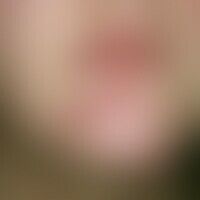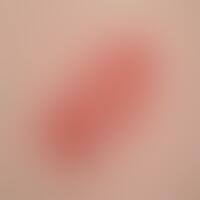Image diagnoses for "red"
901 results with 4543 images
Results forred

Polymorphic light eruption L56.4
Light dermatosis, polymorphic: multiple, itchy, highly red urticarial papules, sometimes confluent to large plaques.

Urticaria (overview) L50.8
Urticaria cholinergic: small wheals in the area of the trunk after physical exertion.

Acuminate condyloma A63.0
Condylomata acuminata in an infant; perianal, scrotal and inguinal small, pointy-headed, reddish, soft, rough papules.

Sweet syndrome L98.2

Lupus erythematodes chronicus discoides L93.0
Lupus erythematodes chronicus discoides. sharply defined, reddish, disc-shaped, partly scaly plaques with follicular hyperkeratosis and central atrophy; partly hypopigmentation or hyperpigmentation. chronic course. photosensitivity.

Palmar and plantar filides A51.3
Palmar and plantar filids: disseminated, reddish-brown, scaly papules on palms and soles; no itching; generalized lymphadenopathy.

Psoriasis vulgaris chronic active plaque type L40.0
Psoriasis vulgaris chronic active plaque type: in addition to long-term psoriatic plaques, disseminated, small psoriatic lesions as a sign of "relapse activity".

Lichen sclerosus (overview) L90.4
Lichen sclerosus et atrophicus. extensive infestation. extensive fresh and older bleeding.

Carcinoma of the skin (overview) C44.L
Cutaneous carcinoma: a flat growing, circinally limited, red plaque, without any symptoms Diagnosis: Bowen's disease

Dermatomyositis paraneoplastic M33.1

Lichen planus bullosus L43.10
Lichen planus bullosus: Multiple, solitary, vesicularly transformed red nodules on the lower leg in a 55-year-old man with lichen planus.

Prurigo simplex acuta L28.22
Prurigo simplex acuta infantum: Disseminated, very itchy, inflammatory papules and papulovesicles on the face in a child.

Folliculitis barbae L73.8
Folliculitis barbae: Massive purulent (ostio-)folliculitis after application of a tyrosine kinase inhibitor.











